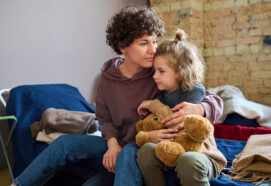The need to spot and support students who have experienced trauma has become increasingly urgent and necessary within educational settings. The likelihood of children and young adults experiencing traumatic events increased significantly during the lockdown periods of the pandemic. The national rise in incidents of domestic abuse recorded by the police indicate that more children and young adults may have been in households where violence was occurring for the first time. Additionally, other potentially traumatic situations such as witnessing the death of loved ones and being at home with parents who may have been struggling with their own mental health, or were struggling financially due to COVID- related redundancies. Having collaborative relationships with families is a vital part of understanding the impact of trauma on a child, and understanding their trauma history will give you some vital clues as to how to support them in the best way. This blog aims to give educational staff guidance about how to identify students who have experienced trauma and offers some practical suggestions about how to support them in within an educational setting.
How to spot students who may be struggling with trauma in your school
There will be a mixture of signs and behaviours which you may observe in children and young adults when they have experienced trauma. It is important to be mindful that these will be specific to each child and even if a group of children experience a shared or collective trauma, it may affect them differently. The impact of trauma on the body is significant and systemic. As Bessel Van Der Kolk says, “Long after a traumatic event is over, it may be reactivated at the slightest hint of danger and mobilize disturbed brain circuits and secrete massive amounts of stress hormones.” [1](Van der Kolk, 2014)
It can affect children physically through a range of symptoms which you might observe in your classroom. They might regularly present with stomach issues/pains, headaches, chest pains, a racing heart or insomnia. These are all potentially caused by their sensitive stress response which has being reactivated in the present due to something which has caused an emotional or physical ‘flashback’ to their past trauma. This could be a certain smell, noise, phrase or experience which would be related to their original trauma.
Alongside these physical signs, trauma can also have a significant impact on the child’s ability to form relationships/attachments with others and can affect their self-esteem and confidence. This can be evident in their behaviour in all areas of school life both within and outside of the classroom.
- They might find it overwhelming to work in groups with new students and no guidance about roles within in.
- They might find it hard to communicate with new adults in their lives such as teaching assistants or supply teachers.
- They might find it hard to cope during ‘non-teaching’ parts of the day such as before school, break and lunch times.
- They might struggle to cope with sudden changes in seating-plans, teachers, resources etc.
- They might feel angry or upset with no apparent external cause.
- They might not be able to concentrate for long periods of time on tasks.
- They might withdraw in lessons and not be able to read out loud in front of others, or be able to answer questions when asked.
- They might struggle with sensory hypersensitivity caused by the classroom they are in. This would show as noticing sounds or changes in lighting in a way that other students might not.
Practical support option for students who have experienced trauma
Creating safe, consistent and enjoyable learning spaces will have a great impact in reducing the potential for ‘triggering’ feelings and will allow the child’s brain to be able to access learning and play. There are some really practical strategies which can be introduced to their school experience which will be a huge support.
- Having a clear and consistent set of routines and expectations about behaviour will help the child to feel safe and secure and eliminate some of the potential for triggering situations such as shouting, aggression and bullying from other students.
- Giving them advance notice of any changes which will be happening in seating plans/ classroom layout/routines. This will give students time to ask any questions and emotionally prepare for the change.
- Having a classroom which reduces opportunities for sensory hypersensitivity. This could be making sure that the lights you have in your classroom are not fluorescent or flickering. Any background sounds coming from electronic devices need to be considered for example, the speakers might emit a background ‘hum’ when they are in standby mode.
- Ensuring that there are a range of clubs or other extra-curricular opportunities which give children chances to make friends, connect with others and foster a sense of safety which comes from belonging to a group. It may be that as their teacher, you need to accompany them to this club initially so that they have that safety net and familiarity. As Dr Bruce D. Perry says in his book on trauma, ‘What happened to you?, “Connectedness has the power to counterbalance adversity.”[2] (Bruce D Perry and Winfrey, Oprah, 2021)
- Allowing students the chance to emotionally regulate in a way that for them and is known to all staff. For example, if a student has become ‘triggered’ and are struggling to cope with extreme anxiety, it may be agreed with their parents/carers that they can use a range of methods to regulate in a toolkit. They may want to have a few minutes outside the classroom to sit quietly and take some deep belly breaths to calm things down, they might want to doodle in your lesson in a notepad, they might need to leave the lesson and go to speak to an identified accessible and safe adult and then return afterwards. It may be that the child is able to come up with their own way to regulate and might suggest this to you. For example, I had a student who asked to use a fidget toy under the desk when she was feeling anxious and this helped her to manage tricky feelings.
- Giving students opportunities for success in a way that is personal to them. Celebrating small successes will allow them to build their self-esteem and be able to tolerate experiences of failure if/when it occurs.
Conclusions
The impact of trauma on children is significant and life-changing. However, by understanding the signs and behaviours to be aware of in children and young adults in our schools, teachers can identify how they can work alongside parents to provide them with comprehensive support. This will ensure that they can access learning in the best way and develop supportive relationships with peers and adults alike. Offering a range of support will enable the child to feel heard and supported in a way that works for them and creating a trauma- aware culture in schools will mean that staff know how to help them to overcome some of the barriers which trauma may be creating for them within the classroom. This can allow them to start to feel a sense of agency in their lives, learn how to emotionally regulate, and restore the idea of connecting positively with others and developing relationships.
Bibliography
- The body keeps the score- Bessel Van Der Kolk
- What happened to you? Dr Bruce Perry and Oprah Winfrey
- Building a Trauma- informed restorative school Joe Brummer
[1] Van Der Kolk, Bessel (2014) The Body Keeps The Score page 2
[2] Perry, Bruce and Winfrey, Oprah What happened to you? Conversation on trauma, resilience, and healing page 108 (2021)
Other resources
Watch Amy Sayer’s talk from our session ‘Sleep and Screen Time – Pedagogy in Practice’ run in conjunction with the Chartered College of Teaching – the professional body for teaching.



Discussion
Interesting article thank you. My 16 year old niece has regular seizures which following a number of MRIs have been determined as non-epileptic and psychological. She very much dwells on a period of quite severe bullying, and this continues despite her moving schools. Her seizures to me seem to coincide with her talking about friendships, relationships, school or her being in school, but not always. I personally wonder if PTSD could be the underlying cause, but no medical professional seems to have made this link. The epilepsy clinic say her seizures are brought on psychologically and the psychology team haven’t really done very much at all, suggested her school put her on a reduced timetable. Could PTSD be a cause and could EMDR therapy possibly be of benefit?
I wish all my colleagues could have a chance to read this article so they know how to deal with some students better. We are an international school in China. A lot of staff are not trained to understand kids with trauma, not to mention how to give them that extra support. Some kids have trouble sitting down but fidget toys could help them calm down. Some kids are hypersensitive to noise and could get overwhelmed or withdraw if they see things that make them have flashbacks. I think it’s important for teachers to identify their triggers and know how to manage them gently and empathetically. However, without teaching aids, it could be quite challenging to manage the whole class and send extra support to the kids in need at the same time
This blog highlights the critical need for educators to recognize and support students who have experienced trauma, especially in light of increased risks during the pandemic. It underscores the value of collaborative relationships with families to understand each child’s trauma history and provides practical strategies for creating a safe, supportive, and responsive learning environment.